When and how to prune gooseberries after harvest and fall
The main attention of novice gardeners when caring for gooseberries after harvest and in the fall should be directed to timely pruning of the bush. This very important agrotechnical technique contributes to the correct formation of the crown, maintaining good growth, increasing the yield and quality of berries. In addition, by properly pruning the "northern grapes", it is possible to prevent the exposure of internal branches, improve the growth and fruiting of aging shrubs, and lengthen the period of their productive age.
About why, when and how to prune gooseberries in the fall, as well as the schemes for pruning by years and schemes for rejuvenating the old bush, we will tell in the material below.
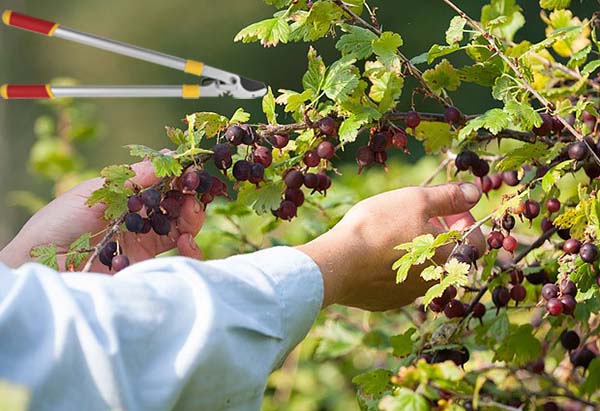
Content
Why cut gooseberries
Like most berry bushes, the gooseberry grows quite quickly, begins to shade itself, it hurts more often and its fruiting worsens.Therefore, every year, extra branches must be cut off, and also a bush must be formed. Starting from 5-6 years old, it is recommended to carry out anti-aging pruning, removing the oldest (5-6 year old) branches.
Thus, autumn pruning of gooseberries is necessary in order to:
- improve the flow of sunlight and air to the branches located inside the bush;
- increase the volume and quality of the crop;
- to give the shrub the correct shape, that is, to simplify the care of the gooseberry, because it is much easier to care for and pick berries from cultivated bushes than to carry out these manipulations in the hopeless thorny thickets.
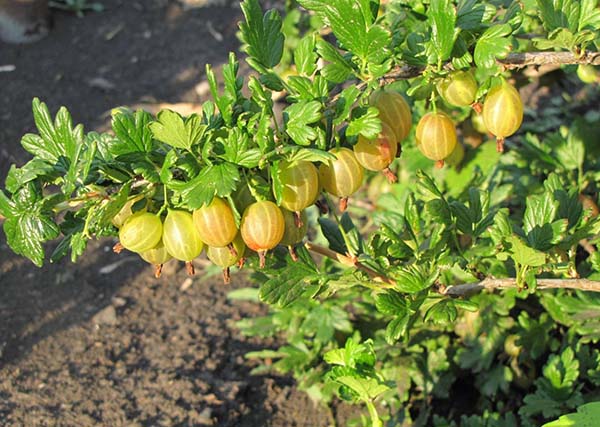
Of course, you do not need to cut the gooseberries in the fall, but you will hardly be able to harvest a generous crop from an unkempt plant.
However! Incorrect and untimely pruning of gooseberries adversely affects the condition of the shrub, it weakens and bears poor fruit. Therefore, so that pruning of gooseberries after harvesting and in autumn is not done in vain, you need to know the optimal timing and basic rules for this important garden manipulation.
When to cut gooseberries in the fall: optimal timing
If spring pruning should be carried out as quickly as possible, until the growing season has begun at the bush, then pruning the gooseberry after fruiting (harvesting) can be divided into two stages:
- Dried and diseased branches (sanitary pruning) remove immediately after harvest (even in summer).
- And anti-aging and shaping pruning gooseberry is already taken in the fall, and it is desirable after the leaves fall, but before the onset of frost and a stable negative temperature.
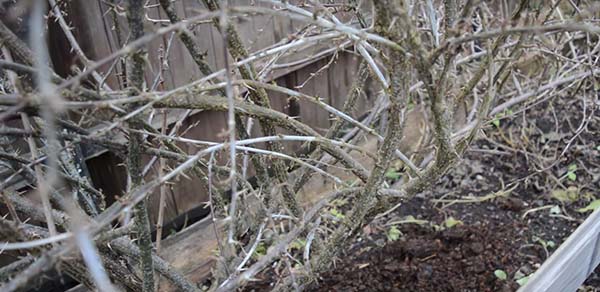
Note! After harvesting (in summer), you cannot carry out a shortening pruning, otherwise you will provoke the appearance of new growths that will not have time to woody before frost and will simply freeze and dry out in winter.
In this way, approximate pruning time gooseberry in the fall in the Middle lane (Moscow region) - October-November, after harvest - from the end of July to September.
When is the best time to prune - in autumn or spring
Of course, gooseberries can be cut in the spring, but it must be done early enough, even before the buds open, that is, before the sap flow begins. If you do this later, then the plant will simply lose some of the juice in vain to bloom those buds, which we still cut off. In addition, there are a lot of things to do in the spring. Therefore, it is much more practical to produce exactly the autumn pruning of gooseberries.
Video: pruning gooseberries in the fall
How to prune gooseberries in the fall: basic rules and recommendations
Advice! Pruning an old gooseberry bush is very convenient to carry out with a pruner with long handles (lopper). In principle, you can use a regular pruner (for cutting young branches), but working with it, you will definitely prick (the bush is prickly), which means that you should also wear protective gloves (optimally - welder).
What branches and shoots gooseberry need to cut after fruiting (harvesting) and in autumn:
- All sick (for example, amazed powdery mildew), covered with moss and lichen, dry and damaged.
- All lower branches, which are located very low, practically lying on the ground... They are in the shadow of other shoots, so they do not have enough food (sunlight), which means that they cannot bear fruit normally and are more susceptible to diseases than others.
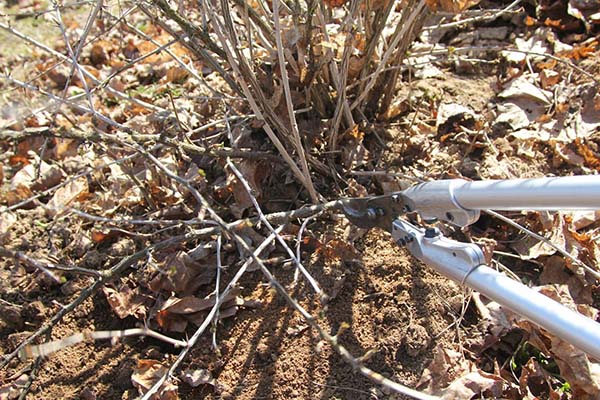
- All branches that are excessive thicken the crown (grow in the center or inside the bush), and confuse (compete) with others.
Important! If there are branches bent downwards or horizontally, then they must be shortened so that the outermost buds on the remaining part (or lateral shoots) are directed vertically or at a good angle upward.
- All are cut completely old brancheswho more than 5 years and older.
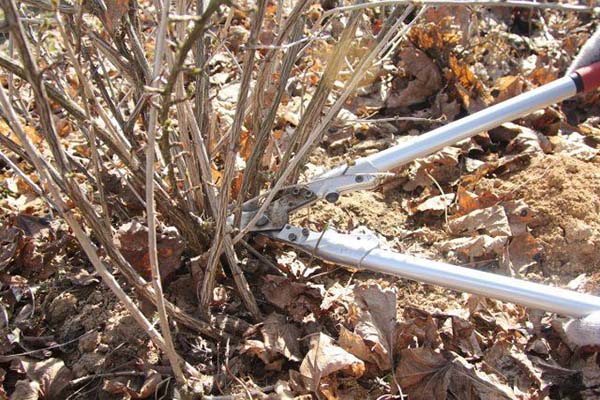
- Weak young growth and thin twigs must be shortened to the largest bud, which does not look into the bush, but out.
Worth knowing! How to distinguish between weak and strong shoots? Strong shoots have an annual growth of at least 50 cm.
- Strong replacement shoots (zero) -those shoots that grow from the ground, you needshorten by 1/4 over the kidneysto branch better. Restweak young (zero) shoots, you need to completely cut out so that they do not shade the crown. There should be 3-4 of them left.
how prune branches and shoots correctly gooseberry in autumn:
- All old and under branches as well as unnecessary replacement shoots (zero)you need to cut it completely to the base (flush with the surface), without leaving any hemp.The taller hemp stumps ("hedgehogs") you leave, the more unsightly the bush will look.
- All excess growth and competing branches also need to trim without stumps closer to the branch point (that is, you cut the old branch to the point of branching and growth of the young growth).
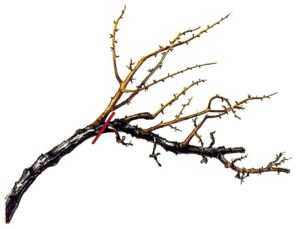
- By shortening weak young shoots and branches for better branching, before trimming them,on the outside of the branch Need to find strong kidney and only then cut the branch above this bud, departing from it by 0.5-1 cm.
- Distinguish young shoots from old branches it is possible by their thickness and color: old branches - thick and dark brown (almost black), young ones are still relatively thin and have a lighter wood, i.e. the older the branch, the thicker and darker it is.
Video: how to properly trim gooseberries
Interesting! Some gardeners do not prune gooseberries according to the rules, because this greatly simplifies the process and makes it less labor and time-consuming. At the same time, no special losses or a decrease in fruiting are observed at all, but on the contrary, the shrub gives excellent yields. For more information on such an autumn pruning of gooseberries, see the video below.
Video: how to cut gooseberries not according to the rules
Scheme of conducting formative pruning by years
If you have planted a bush seedling and want to form a compact and abundantly fruiting bush, then you should adhere to a certain gooseberry formation scheme, taking into account the age of the bush (pruning by years):
- After planting a seedling - all shoots (if it is not the only one) are shortened, while you need to leave 3-4 buds above the soil surface.
- after 1 year - all young shoots are cut into 4-5 buds and 2-3 zero shoots are left. In this case, it is worth starting to carry out sanitary pruning - to remove diseased branches and those branches that do not grow vertically, but are directed to the center of the bush.
- after 2 years (3-year-old seedling) - pruning (pinching) of all zero shoots by 1/4 is carried out, as well as shortening by 1/4 of the growth growing on skeletal branches. This will provoke the growth of a young shrub in width, and not upward. Don't forget about sanitary pruning.
- in 3-4 years - fully corresponds to pruning on a 3-year-old seedling. Sanitary pruning.
- for 5 years and beyond - the rejuvenating pruning of the bush begins. First, sanitary pruning is carried out, then all old shoots are cut out (rejuvenating pruning) and shaping is completed - everything is like 2 years old (3-year-old seedling).
- And don't forget leave 2-3 new zero replacement shoots every year.
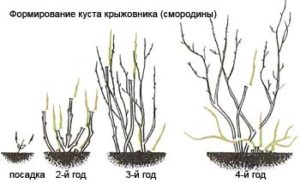
There is also standard method of forming a gooseberry bush.
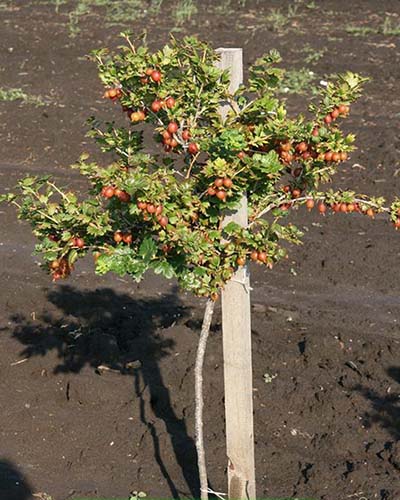
Pruning by year should be done according to the following scheme (by year), shown in the picture below:

Video: standard gooseberry
How to prune an old and neglected bush (anti-aging pruning)
Note! Prune old branches without fanaticism. Gooseberry bears fruit on a young growth, which is formed on old branches (the most fertile 3-5 years old), and this is its difference from currants.
If you inherited (inherited or bought from a previous owner) an old plot with overly thickened gooseberry bushes that give a very small crop, then in order to restore fruiting, you need to carry out the correct anti-aging pruning of the shrub. Moreover, it is better to divide it into 2 stages.Naturally, it is better to start with sanitary pruning, and then get rid of all old (anti-aging pruning) and other unnecessary branches. The bush is cleared, which means that all conditions are created for the active growth of new young shoots.
Scheme of rejuvenation and pruning of an old gooseberry bush:
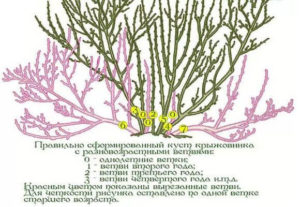
Video: rejuvenating autumn gooseberry pruning
Interesting! There is quite radical method of rejuvenation old gooseberry - cut it to zero.
What to do before and after pruning gooseberries in autumn
Recommended post-harvest gooseberry care (in addition to pruning) also includes:
- cleaning the trunk circle from old mulch and litter so that pests do not hibernate there;
- loosening;
- watering and fertilizing;
- transplant (if necessary);
- direct trimming;
- treatment against pests and diseases;
- shelter (new mulching) for the winter.
By the way! The site has a separate detailed article about how to care for gooseberries in the fall to properly prepare for winter.
In order to avoid mistakes when pruning gooseberries in the fall, after harvesting, it is very important, especially for a novice gardener, to adhere to the optimal timing, rules and schemes for pruning the bush. In addition, you should not ignore other autumn activities for caring for the berry for the winter. Only then will you get the desired effect.
Video: autumn gooseberry pruning
By the way! Gooseberry pruning is very similar (almost identical, but there are a couple of important differences and nuances) to currant pruning... Therefore, if you understand the pruning of one of the berry crops, then understanding how to properly prune the second will not be difficult.

